[ Retro Scan ] 9.9.99 – Dreamcast Turns 20 in America
September 9th, 2019 by Benj Edwards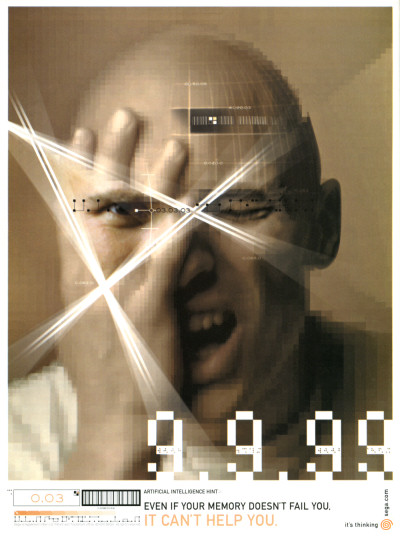 Gaming used to be very painful
Gaming used to be very painful
On September 9, 1999, Sega launched the Dreamcast in America. This is one of its pre-launch print ads.
20 years later, I am still not sure exactly how to interpret this advertisement. The tagline in the corner seems the most obvious part. To me, “it’s thinking,” implied that the Dreamcast packed a powerful CPU and could generate complex gaming experiences.
But the screaming, eye-pain stuff? At the time, video game advertisement in the US leaned toward cryptic and edgy. This was drumming up interest for a launch date, so it threw in some mystery, not even naming the console itself.
But if taken literally, the ad makes it look like playing games on this upcoming console could be a painful or negative experience. Somehow marketers calculated that dark and painful imagery attracted American gamers. What this cultural masochism says about American gamers, I am not sure. That’s a deep one to unravel.
I didn’t like the ad much at the time. But I was hyped for the Dreamcast launch, so maybe it worked.
9.9.99
1999 was a big year for me. In June, I graduated high school and started my first full-time job. A month later, I moved out of my parents’ house. I had money to burn, my own bank account, my own credit card. So I did what came naturally to an 18 year-old at the time: I bought a Sega Dreamcast. It was one of the highlights of my adult life — a symbol of independence.
The way I purchased the Dreamcast made it a notable experience. I ordered it from Amazon.com at a time when most customers still associated Amazon with book and CD sales. The firm had only recently expanded into selling “toys,” which is how they categorized the Dreamcast at the time. Ordering a game console and having it arrive on your doorstep without leaving your house felt like magic.
I paid $199.95 for the console itself (about $306 today, adjusted for inflation), and I also bought a copy of Sonic Adventure, a VMU, and an extra controller. I splurged on next-day air shipping. The total cost was $343.60 (or $525.06 today), which was a huge load of cash to set down.
I must have saved up, because my credit card had a $200 limit at the time (no, it’s not a typo — this was shortly before the insanely predatory credit card boom that got so many people in trouble).
A Breath of Fresh Air
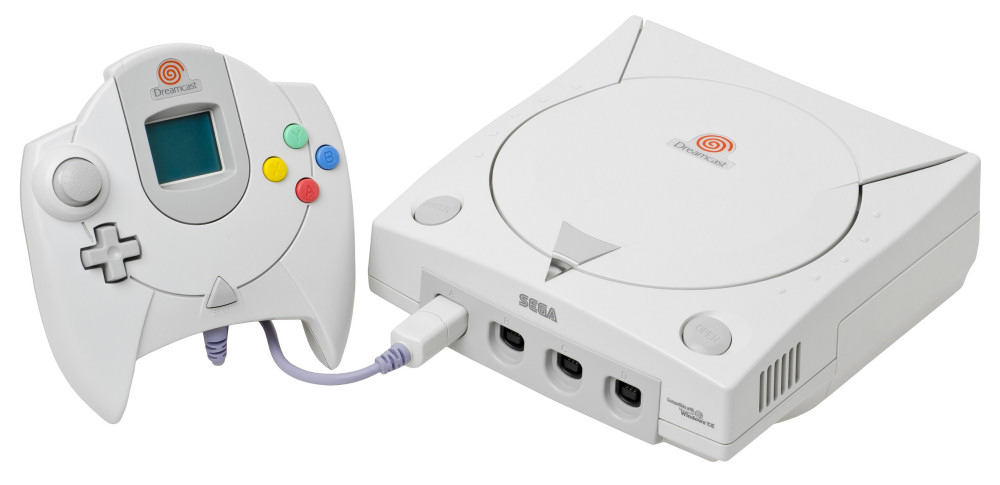 When the Dreamcast arrived, I rejoiced. It was every bit as polished, well-made and fun as I had read in EGM. Sonic Adventure satisfied and delighted. The console itself, compact and sleek with a built in modem, could dial-up and browse the web with an included CD. And those high-res graphics! Incredibly sleek. It was an amazing console experience for 1999.
When the Dreamcast arrived, I rejoiced. It was every bit as polished, well-made and fun as I had read in EGM. Sonic Adventure satisfied and delighted. The console itself, compact and sleek with a built in modem, could dial-up and browse the web with an included CD. And those high-res graphics! Incredibly sleek. It was an amazing console experience for 1999.
What I love most about Sega’s Dreamcast period (1999-2001) is that the firm’s American branch allowed measured amounts Japanese quirkiness to make it overseas unfiltered and minimally localized. Sega crafted a cohesive look-and-feel that exuded creativity. With the Genesis and Saturn in the US, everything had been black on black, dark and edgy. The Dreamcast was white — a breath of fresh air — and had a playful name and a playful logo. The Japanese-developed games packed silly voices and Japanese arcade-style enthusiasm.
We even got Seaman in the US! A swimming fish with a man’s head that you talked to through a microphone that plugged into the controller. How wacky and fun is that?
Among its most innovative and playful peripherals include the 56K modem, the controller (with its dual VMU slots), the VMU itself (with its tiny screen and integrated controller), the keyboard and mouse, the VGA adapter, the fishing controller, the microphone, the broadband adapter, and the DreamEye camera (Japan only).
These devices show a pattern of playful innovation that I still feel has not been matched in its density to this day (although the Wii comes close). It was the sheer scope of it all, delivered within less than two years, that still impresses me.
A Life Cut Short
And that’s the most tragic part of the Dreamcast story. When Sega shut down production of the console in 2001, sales had been lagging, and Sega was losing money. But critical response was positive and consistent. The Dreamcast had fostered an incredible game library, and it bristled with untapped potential (both online and off). For fans of the console, we wanted more.
But fearing the intense juggernaut of Sony’s massively successful PlayStation 2, Sega made a shrewd business decision and pulled the plug on the Dreamcast in March of 2001.
Never again would they make game console hardware, although I’m still holding out hope that they eventually change their mind — even if only to completely immerse myself in that unique, quirky Sega gaming culture once again.
Discussion Topic: What are your memories of the Sega Dreamcast launch? (Alternatively, your impressions the first time you played the Dreamcast)


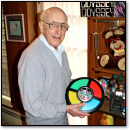
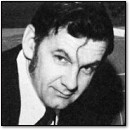
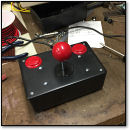
September 9th, 2019 at 1:56 pm
I remember 9/9/99 was also the night that the MTV Video Music Awards aired (hey, remember when the VMAs were culturally relevant?). Sega had purchased a significant amount of the advertising space during the program that year.
I also remember in May 1999 that Newsweek can a cover feature entitled “What You’ll Want Next” describing the next wave of consumer electronics. I recall that the Dreamcast was featured on the cover of this issue. It’s one of those “did I dream that?” type of things because I cannot find that cover anymore.
September 10th, 2019 at 8:28 am
Great to hear from you, Mike. Glad to see I still have at least one reader left. 🙂
Maybe that magazine wasn’t Newsweek? Memory is weird like that. I will swear I remember something but a key detail turns out to be different.
September 10th, 2019 at 10:03 pm
The Dreamcast was one of the last brick and mortar console purchases I made, having since shopped online. I was there at launch and still have my pre-order promotional T-Shirt.
My purchase was made at Electronics Boutique. It was around this time (1999) that my local mall experienced a flurry of software / gaming store closures and openings – a period that tragically began with the closure of our local Waldensoftware – by far the most spacious, well-run software store in my area.
The store was packed. I recall vividly the sales clerk pushing hard, almost holding my console hostage, to convince me I should buy the replacement policy. He explained the policy was so unconditional that I could walk into the parking lot, intentionally light my Dreamcast on fire, and immediately claim my replacement. At the time I though this to be weird, untrue, and not as civilized as my Waldensoftware experience.
The Dreamcast came along at the right time for me. My friends and family gathered around it constantly, forging a lot of great gaming memories we still talk about today.
September 12th, 2019 at 7:17 am
“I bought a Sega Dreamcast. It was one of the highlights of my adult life.”
That’s actually quite sad.
September 12th, 2019 at 10:50 am
It wasn’t sad for me — it was my first game console I bought with my own money while living on my own. It was my first console ordered online at a time when that was unusual. And it was an awesome system with great games.
As far as it being a highlight of my life, the weight I assign to video game experiences in my hall of memories has served me very well as a collector, journalist, and historian. I’ve built a career out of it. Video games may mean a lot more to me than most people, but that’s exactly why I’m not like most people. 🙂
September 12th, 2019 at 10:49 pm
Don’t worry, I still subscribe to your RSS feed. 🙂
It was definitely Newsweek. A friend of mine had a subscription and read it every week. I borrowed this issue so I could scan some of the images inside because I wanted to really analyze the predictions. And then 10 years later (2009), I finally got around to dissecting the amazing futuristic predictions:
https://multimedia.cx/eggs/newsweek-future-scans-time-capsule/
I should probably revisit it again now that another decade has passed.
September 12th, 2019 at 11:07 pm
Aha! I wasn’t crazy. The page scans from my blog post listed May 31, 1999 and searching for that exact date + Newsweek brings up this archive:
http://findit.library.yale.edu/catalog/digcoll:558390
There’s the Newsweek cover with a DC controller.
September 16th, 2019 at 3:53 pm
Hey Benj, loyal (if relatively recent) reader here.
The DC was important to me as well. I’m just a bit older than you — I was well and truly living on my own at the time as I’d gotten my first job in the SF bay area and was all alone while my partner had a few months left of university to finish. The job (while unremarkable on its own) was flush with dot-com cash. Lots of disposable income meant that I, too, was willing to pony up on launch day (or soon after? I can’t remember). I’m pretty sure I bought Sonic Adventure, along with two controllers and a VM. With a lot of free time and being recently uprooted from where I’d been living, having a new console to explore was a perfect fit.
I was pretty disappointed with how fast the VM ate batteries; in a world where rechargeables were easy to come by, I felt like I needed those watch batteries at hand like a roll of quarters.
Everything else was amazing, though. I remember marveling at the quality of the reflection maps and the ease at which the DC had surpassed the shortcomings of both the ps1 (texture swimming) and the n64 (heavily blurred lower-res texures) in one fell swoop. I was in heaven.
many years later, a friend offloaded his collection on me, including the two Dreamcasts, more colored controllers than you could shake a stick at, the broadband adapter, the fishing controller, a keyboard, and some crazy 2-person arcade stick that had been used exclusively for Soul Calibur.
I just wish I’d been able to experience Phantasy Star Online — I totally missed the boat on that one.
September 16th, 2019 at 5:44 pm
Yeah, lots of readers still here. Just watching for posts. 🙂
February 8th, 2022 at 12:05 pm
I won Sega’s Dreamcast launch contest (and have photo evidence). My Dreamcast, a VGA adapter, and all launch titles were personally delivered a week before launch (I lived near Sega HQ in San Fran). I was flown to NYC to attend the VMA awards, stayed in a hotel with many of the celebrity attendees, and rode to the awards in a limo with Peter Moore. I never sold that original Dreamcast, and it is still my favorite console. Thanks for the trip down memory lane.